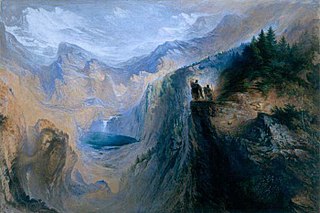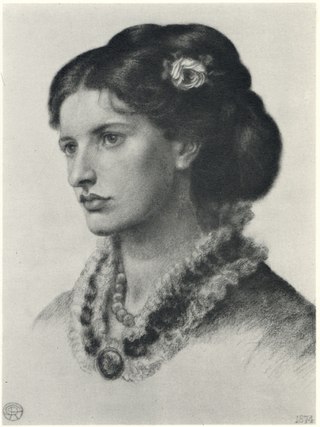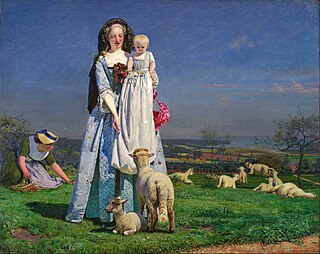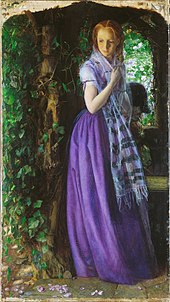
Ford Madox Brown was a British painter of moral and historical subjects, notable for his distinctively graphic and often Hogarthian version of the Pre-Raphaelite style. Arguably, his most notable painting was Work (1852–1865). Brown spent the latter years of his life painting the twelve works known as The Manchester Murals, depicting Mancunian history, for Manchester Town Hall.

Joseph Mallord William Turner, known in his time as William Turner, was an English Romantic painter, printmaker and watercolourist. He is known for his expressive colouring, imaginative landscapes and turbulent, often violent marine paintings. He left behind more than 550 oil paintings, 2,000 watercolours, and 30,000 works on paper. He was championed by the leading English art critic John Ruskin from 1840, and is today regarded as having elevated landscape painting to an eminence rivalling history painting.

The Pre-Raphaelite Brotherhood was a group of English painters, poets, and art critics, founded in 1848 by William Holman Hunt, John Everett Millais, Dante Gabriel Rossetti, William Michael Rossetti, James Collinson, Frederic George Stephens and Thomas Woolner who formed a seven-member "Brotherhood" modelled in part on the Nazarene movement. The Brotherhood was only ever a loose association and their principles were shared by other artists of the time, including Ford Madox Brown, Arthur Hughes and Marie Spartali Stillman. Later followers of the principles of the Brotherhood included Edward Burne-Jones, William Morris and John William Waterhouse.

Frederic George Stephens was a British art critic, and one of the two 'non-artistic' members of the Pre-Raphaelite Brotherhood.

English art is the body of visual arts made in England. England has Europe's earliest and northernmost ice-age cave art. Prehistoric art in England largely corresponds with art made elsewhere in contemporary Britain, but early medieval Anglo-Saxon art saw the development of a distinctly English style, and English art continued thereafter to have a distinct character. English art made after the formation in 1707 of the Kingdom of Great Britain may be regarded in most respects simultaneously as art of the United Kingdom.
Helen Saunders was an English painter associated with the Vorticist movement.
The Greatest Painting in Britain Vote was a survey made by BBC Radio 4's Today programme in Summer 2005 with the aim of discovering the best-loved painting in Britain, in the manner of 100 Greatest Britons and The Big Read. It was criticised for the conservatism of the final selection as well as the unsuitability of the idea for the non-visual medium of radio.

The Last of England is an 1855 oil-on-panel painting by Ford Madox Brown depicting two emigrants leaving England to start a new life in Australia with their baby. The painting has an oval format and is in the Birmingham Museum and Art Gallery.

Work (1852–1865) is a painting by Ford Madox Brown that is generally considered to be his most important achievement. It exists in two versions. The painting attempts to portray, both literally and analytically, the totality of the Victorian social system and the transition from a rural to an urban economy. Brown began the painting in 1852 and completed it in 1865, when he set up a special exhibition to show it along with several of his other works. He wrote a detailed catalogue explaining the significance of the picture.

Manfred on the Jungfrau is an 1837 watercolour painting by the English artist John Martin, now in Birmingham Museum and Art Gallery. The subject of the painting comes from Lord Byron's poem Manfred, specifically Act I scene II. It was painted by a number of 19th-century artists.
Mildred Anne Butler was an Irish artist, who worked in watercolour and oil of landscape, genre and animal subjects. Butler was born and spent most of her life in Kilmurry, Thomastown, County Kilkenny and was associated with the Newlyn School of painters.

John Reinhard Weguelin was an English painter and illustrator, active from 1877 to after 1910. He specialized in figurative paintings with lush backgrounds, typically landscapes or garden scenes. Weguelin emulated the neo-classical style of Edward Poynter and Lawrence Alma-Tadema, painting subjects inspired by classical antiquity and mythology. He depicted scenes of everyday life in ancient Greece and Rome, as well as mythological subjects, with an emphasis on pastoral scenes. Weguelin also drew on folklore for inspiration, and painted numerous images of nymphs and mermaids.

Beata Beatrix is a painting completed in several versions by Pre-Raphaelite artist Dante Gabriel Rossetti. The painting depicts Beatrice Portinari from Dante Alighieri's 1294 poem La Vita Nuova at the moment of her death. The first version is oil on canvas completed in 1870.
Michael James Chaplin (Mike) NDD, RWS, RE, FRSA is a British artist, known primarily for his work in the mediums of etching and watercolour. He was guest art expert on the Channel 4 art programme Watercolour Challenge with Hannah Gordon.

Georgiana, Lady Burne-Jones was a painter and engraver, and the second oldest of the Macdonald sisters. She was married to the Late Pre-Raphaelite artist Edward Burne-Jones, and was also the mother of painter Philip Burne-Jones, aunt of novelist Rudyard Kipling and Prime Minister Stanley Baldwin, confidante and friend of George Eliot, William Morris, and John Ruskin. She was a Trustee of the South London Gallery and was elected to the parish Council of Rottingdean, near Brighton in Sussex.

Lucy Madox Brown Rossetti was a British artist, author, and model associated with the Pre-Raphaelites. She was married to the writer and art critic William Michael Rossetti.

Catherine Madox Brown Hueffer, also known as Cathy, the first child of Ford Madox Brown and Emma Hill, was an artist and model associated with the Pre-Raphaelites and married to the writer Francis Hueffer.

The Graham Children is an oil painting completed by William Hogarth in 1742. It is a group portrait depicting the four children of Daniel Graham, apothecary to King George II. The youngest child had died by the time the painting was completed.

The Pretty Baa-Lambs is an oil on panel work executed in 1851 by the English Pre-Raphaelite artist Ford Madox Brown and part of the collection of Birmingham Museums and Art Gallery.
















